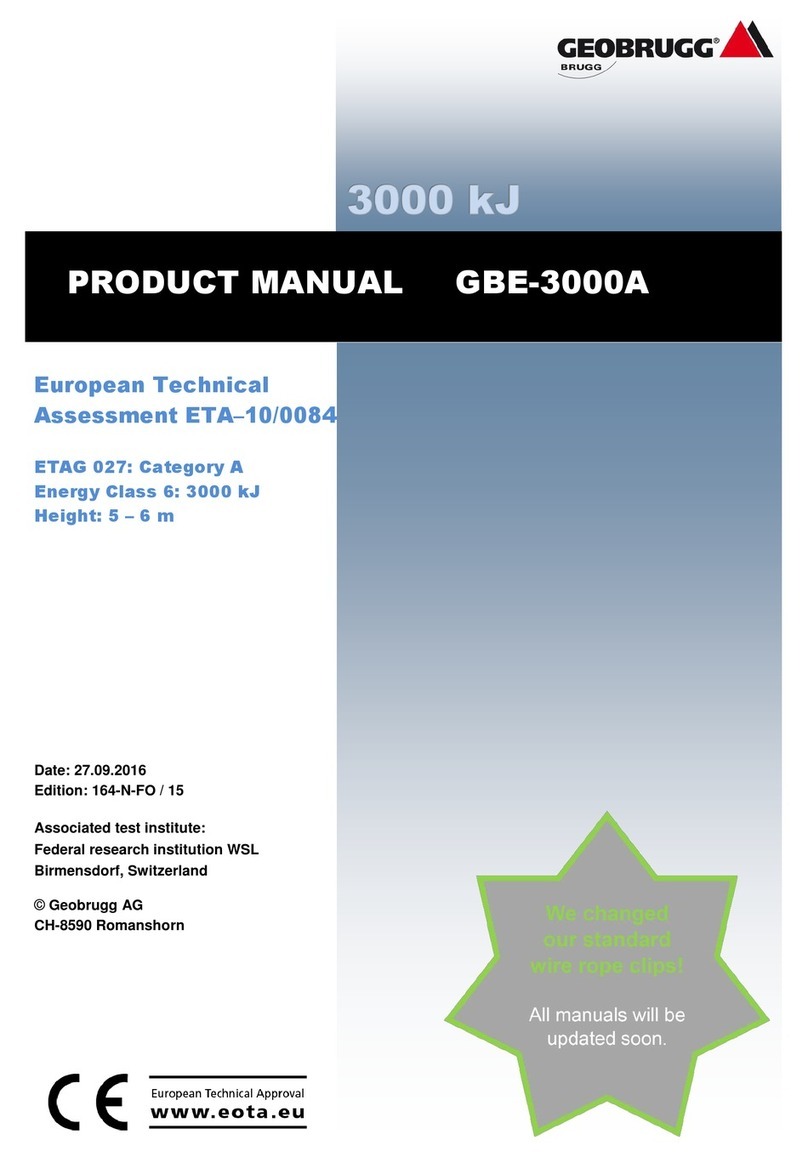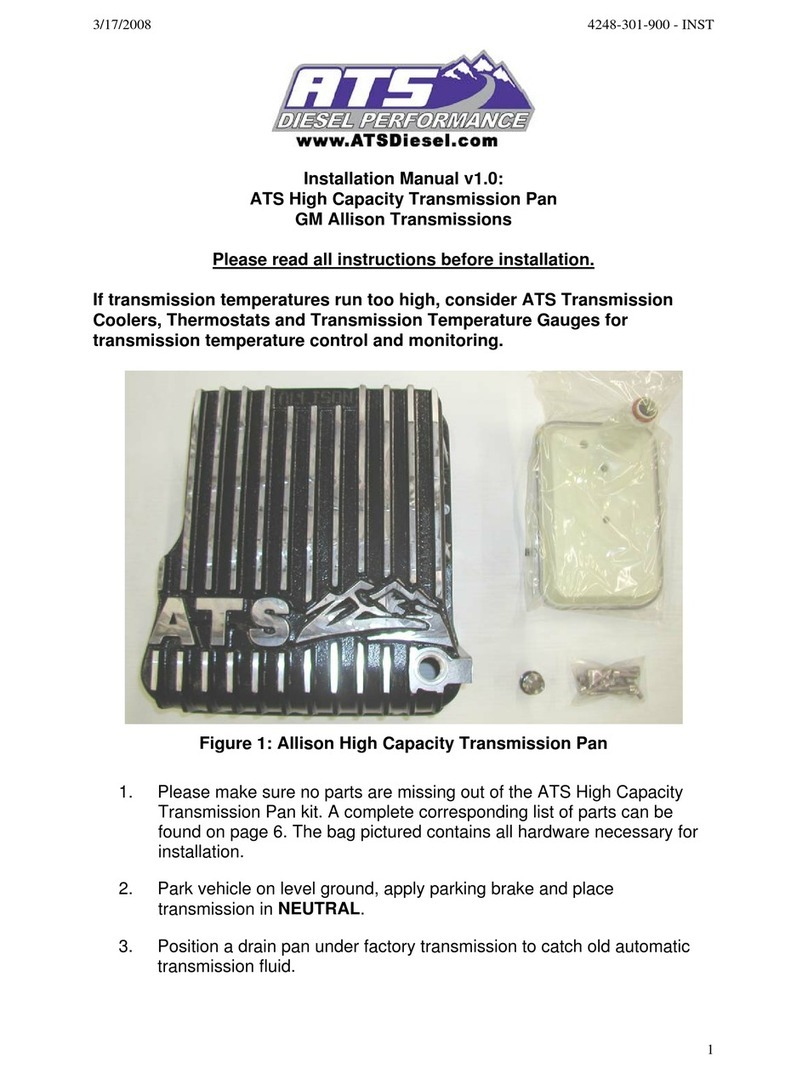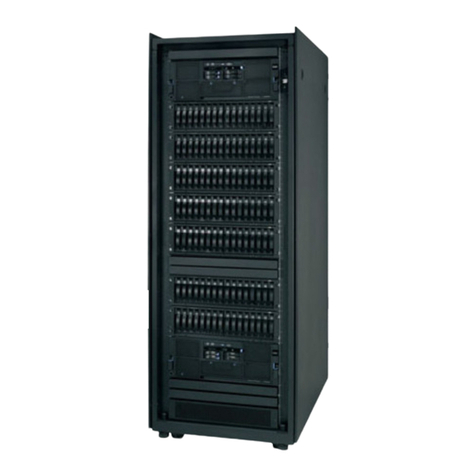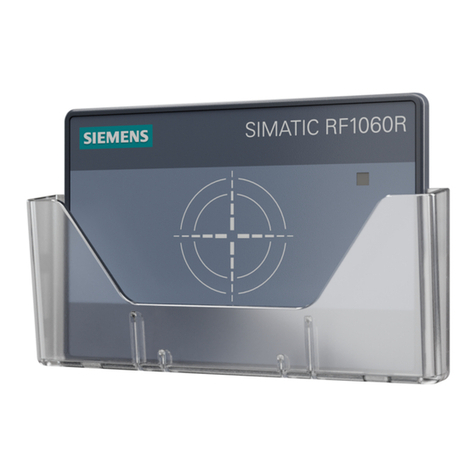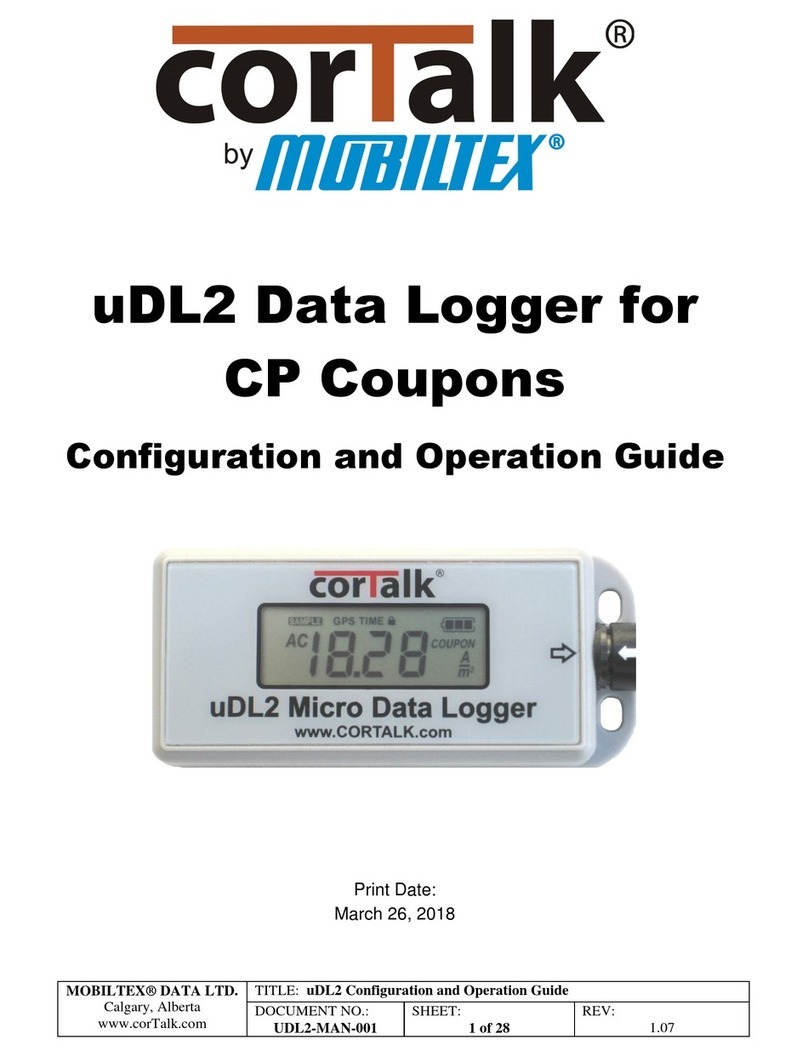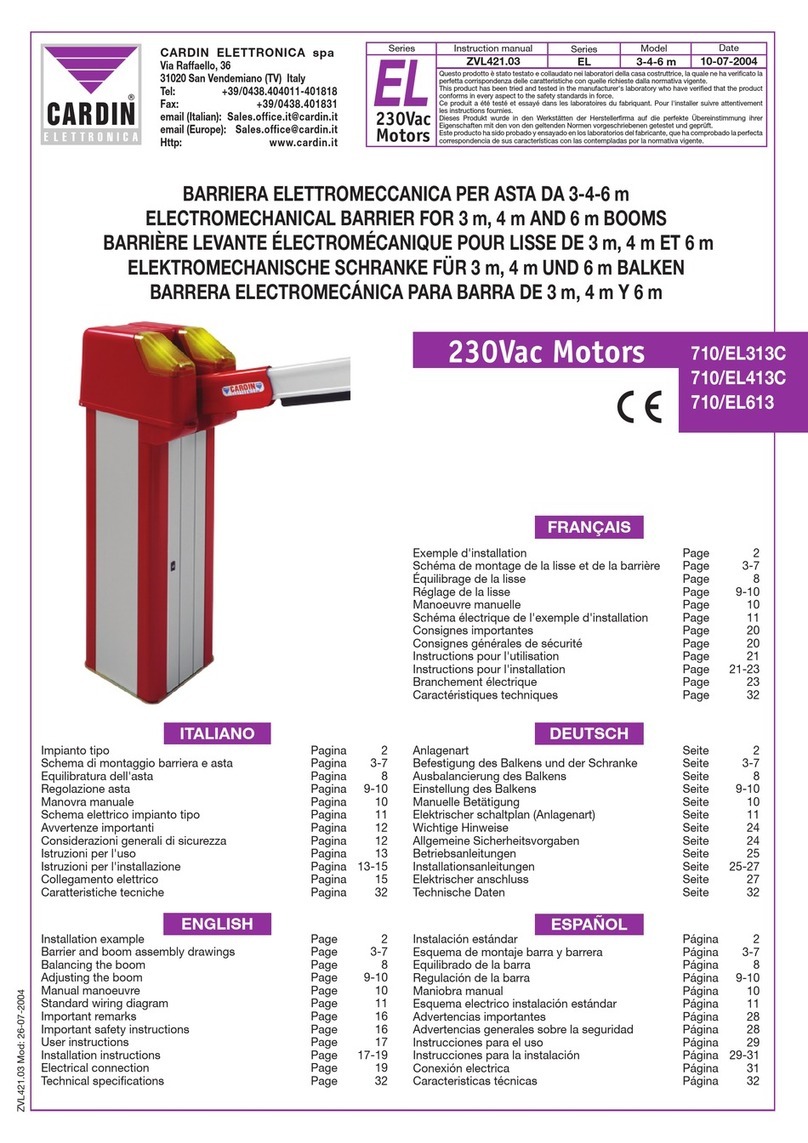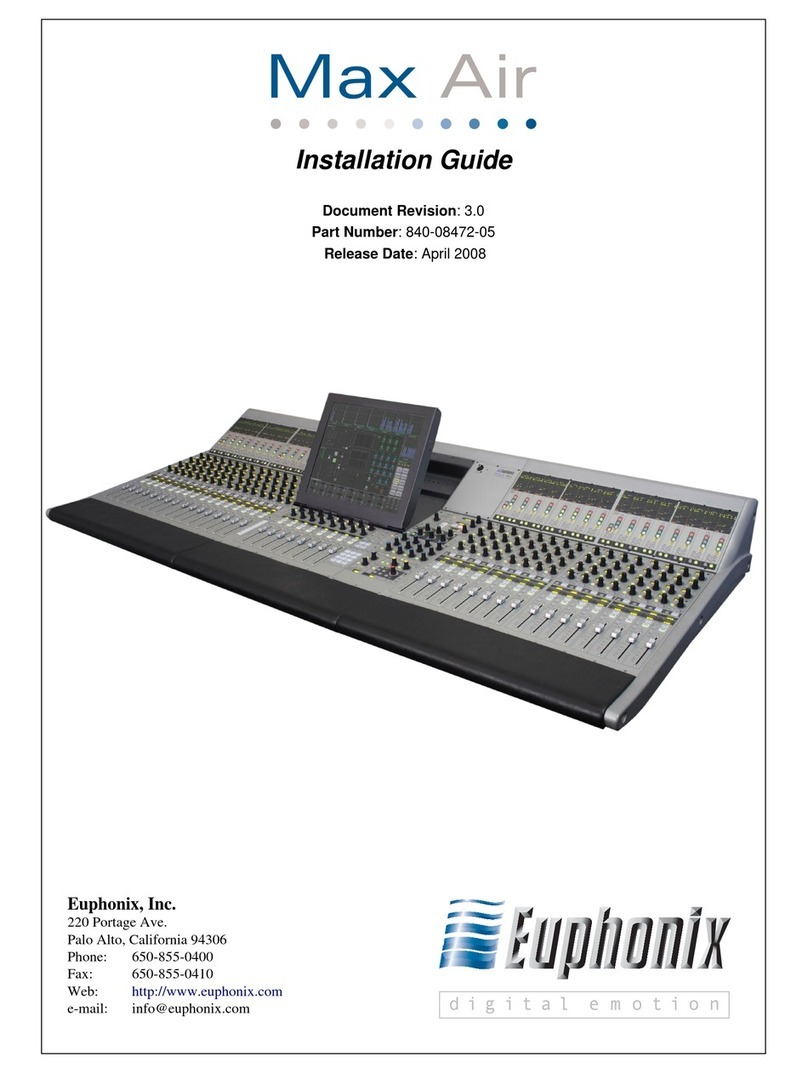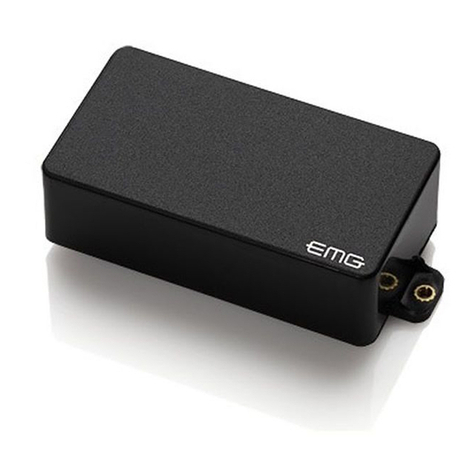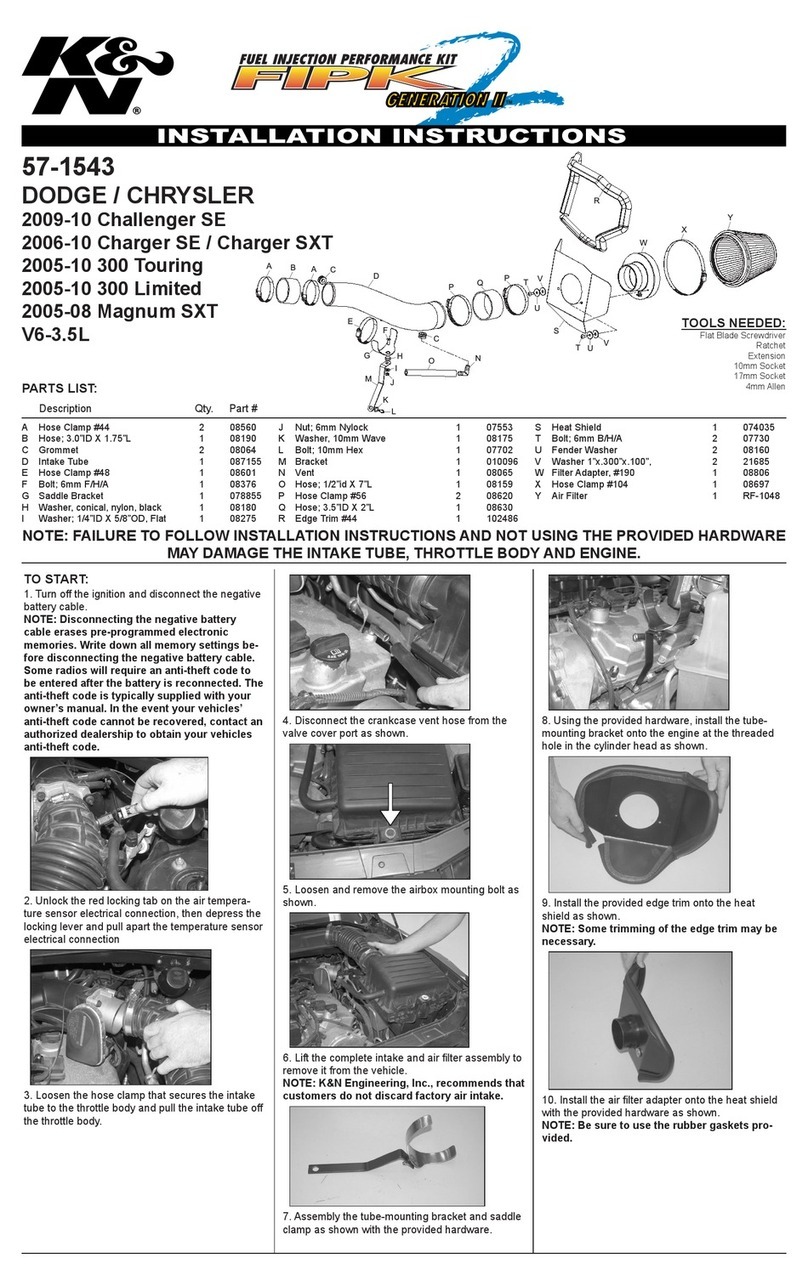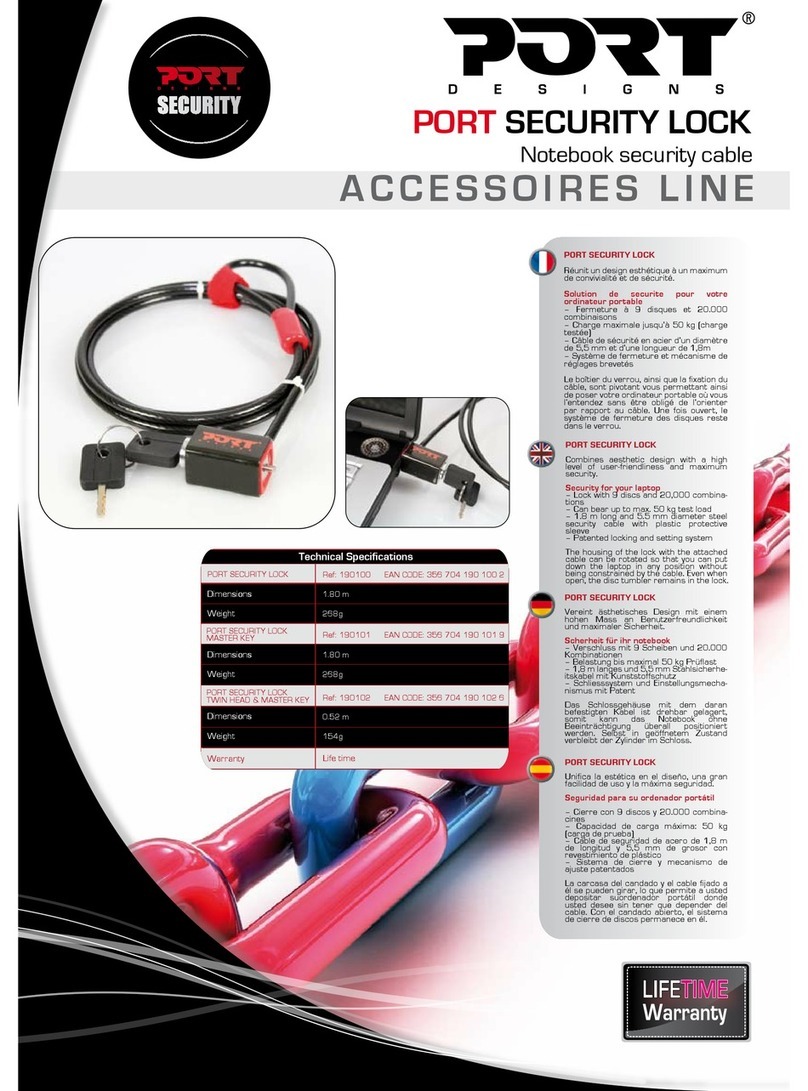Geobrugg GBE-100A-R User manual

European Technical
Assessment ETA 15/0304
ETAG 027: Category A
Energy class 0: ≥100 kJ
Installation height:
2.0 –2.5 m
Test Certificate No. S 14-6
Federal Office for the
Environment FOEN
Switzerland
Attending testing institute:
Swiss Federal Institute for
Forest, Snow and Landscape
Research WSL
Birmensdorf, Switzerland
Date: 24.05.2018
Edition: 08
© Geobrugg AG
CH-8590 Romanshorn
Product Manual
GBE-100A-R
ROCKFALL BARRIER

Page 2/48
© Geobrugg AG, CH-8590 Romanshorn, Switzerland GBE-100A-R / 08

Page 3/48
© Geobrugg AG, CH-8590 Romanshorn, Switzerland GBE-100A-R / 08

Page 4/48
© Geobrugg AG, CH-8590 Romanshorn, Switzerland GBE-100A-R / 08
PURPOSE AND STRUCTURE OF THE MANUAL
This System Manual ensures that the Geobrugg rockfall protection systems are manufactured without any errors
in accordance with the latest technical knowledge, that their area of application is defined, their functional capabil-
ity specified, and their installation carried out and checked correctly.
For an overview of the system, see the appendix at the end of this manual
The System Manual is divided into the following parts:
•Proof of quality assurance
•Stake-out
•Assembly details
•System overview / rope routing
•ISO 9001 certificate
This document makes no claim as to its completeness. It is designed for general standard applications and does
not consider project-related parameters. Geobrugg cannot be held liable for any additional costs that may be in-
curred in special cases. Contact the manufacturer if anything is unclear. The General Terms and Conditions of
Geobrugg AG apply.
RESPONSIBLE FOR CONTENTS:
Geobrugg AG
Schutzsysteme
Aachstrasse 11
Postfach
CH-8590 Romanshorn, Switzerland
www.geobrugg.com
Romanshorn, 24. May 2018
(Stamp / legally valid signatures)

Page 5/48
© Geobrugg AG, CH-8590 Romanshorn, Switzerland GBE-100A-R / 08
I AREA OF APPLICATION
Project planning for rockfall protection systems is based on detailed investigations carried out by specialist engi-
neering firms that take into consideration the following geo-technical aspects in particular and define the area of
application using these:
•Previous rockfall events
•Condition of the rockfall event zone
•Evaluation of stability conditions across the entire rockfall zone
•Rockfall frequency
•Size of the rocks to be caught
•Trajectories and jump heights of the rocks
•Kinetic energy calculations
•Positioning of the structure (local topography taken into consideration)
•Anchoring conditions
II QUALITY OF THE INDIVIDUAL SYSTEM PARTS
Geobrugg AG, previously the Geobrugg Protection Systems department of Fatzer AG, based in Romanshorn,
Switzerland, has been certified to quality management system requirements (ISO 9001:2008) since August 22,
1995, registered under the number CH-34372. The certifying body is the SQS (the Swiss Association for Quality
and Management Systems), to which IQNet belongs. The Quality Manual provides complete information on how
individual system parts (primary material, commercial products and end products) must undergo extensive testing
to rule out insufficient quality. The corresponding certificates can be found in the appendix.
III FUNCTIONAL CAPABILITY OF THE STRUCTURE SYSTEMS
The functional capability of the system is based on 1:1 rockfall tests carried out and tested in Walenstadt,
SG (Switzerland), in accordance with European Technical Approval Guidelines ETAG 027 "Falling Rock Protec-
tion Kits" and the Swiss guideline for the approval of rockfall protection kits. These 1:1 rockfall tests are carried
out using vertical drops into the middle field of a three-field structure with post spacing of 10 m each with the im-
pact speeds reaching at least 25 m/s. The trials are accepted by notified testing bodies and receive a European
approval known as an ETA (European Technical Assessment) as well as a Swiss test certificate from the Swiss
Federal Office for the Environment (FOEN). This system, the GBE-100A-R, has the approval no.
ETA –15/0304 and the test certificate no. S 14-6.
IV QUALITY CONTROL FOR THE INSTALLATION
This System Manual provides detailed information on the planning and installation of the structure.

Page 6/48
© Geobrugg AG, CH-8590 Romanshorn, Switzerland GBE-100A-R / 08
V PRODUCT LIABILITY
Rockfall, slipping, landslides, and avalanches are sporadic and unpredictable. The cause can vary, ranging from
human activity (buildings, etc.) through to force majeure (weather, earthquakes, etc.). The diverse range of trig-
gers of such events make it impossible to use a scientific approach to guarantee the safety of people and material
assets.
Suitable engineering calculations using predictable parameters and the appropriate production of fault-free pro-
tective measures in specific risk zones do, however, reduce the risk of injury and the loss of material assets con-
siderably.
The monitoring and maintenance of such systems are absolutely necessary to guarantee the desired safety lev-
els. This may also be reduced by events, natural disasters, an insufficient dimensioning basis, or non-usage of
standard components, systems, or original parts, but also by corrosion (caused by environmental pollution or oth-
er human factors, as well as other external influences).
The 1:1 rockfall tests test a very intense load fall but only actually show a standardized situation; however, the
lay-outs and designs of the structures used in the field may differ greatly due to the topography of the terrain. It is
not always possible to determine the influence of such modifications and adjustments precisely. Critical aspects
are, for example, post spacing, changes in alignment, rope anchor installation angles, as well as the direction and
speed of rock impact.
Geobrugg can help in protecting against the influences of greater deviations from the standard and specific situa-
tions and provide suggestions for feasible solutions. However, Geobrugg cannot guarantee behavior that will be
the same as in the 1:1 rockfall tests. In critical cases, reinforcing individual components with respect to the stand-
ard barrier is advisable.

Page 7/48
© Geobrugg AG, CH-8590 Romanshorn, Switzerland GBE-100A-R / 08
CONTENTS
1HAZARD WARNINGS ......................................................................................................... 8
2TOOLS FOR INSTALLING ROCKFALL BARRIERS ............................................................. 9
3USING THE WIRE ROPE CLIPS ....................................................................................... 10
4STAKE-OUT DEPENDING ON THE TERRAIN................................................................... 12
5STAKE-OUT GEOMETRY ................................................................................................. 14
6ROPE ANCHOR –PLACEMENT ........................................................................................ 18
7ANCHORING THE POSTS AND ROPE ANCHORS ............................................................ 19
8PREPARING THE MESHES AND POSTS .......................................................................... 21
9INSTALLATION BY CRANE OR HELICOPTER ................................................................. 24
10 INSTALLATION STEPS FOR SUPERSTRUCTURE ........................................................... 25
11 ASSEMBLY DETAILS ....................................................................................................... 28
12 SUPPORT ROPE SEPARATION WITH INTERMEDIATE ANCHOR ROPE .......................... 40
13 SPECIAL SOLUTIONS IN ADDITION TO THE STANDARD ............................................... 43
14 FINAL CHECKS................................................................................................................ 44

Page 8/48
© Geobrugg AG, CH-8590 Romanshorn, Switzerland GBE-100A-R / 08
EXPLANATION OF THE SYMBOLS USED
Safety information: must be followed
Note / reminder so that system is installed easily and correctly
We recommend consultation with Geobrugg
Upslope
Downslope
1 HAZARD WARNINGS
GROUP MANAGER QUALIFICATION
Only a qualified group manager is permitted to manage the installation process.
ROPES UNDER TENSION
Ropes are under tension. Ensure that no one is standing in the danger zone while the ropes are being in-
stalled and pre-tensioned.
RELEASING PARTS UNDER TENSION
Avoid releasing or disconnecting components under tension wherever possible. If, however, this is nec-
essary, please exercise the extreme caution.

Page 9/48
© Geobrugg AG, CH-8590 Romanshorn, Switzerland GBE-100A-R / 08
2 TOOLS FOR INSTALLING ROCKFALL BARRIERS
STAKING WORK
•30 –50 m measuring tape
•Measure stick
•5 red and white ranging poles
•Inclinometer
•Spray can
•Wooden peg or iron peg (min. 3x for each field)
•Hammer/mallet
•Manual
INSTALLATION WORK
•Open-ended or ring wrench
•Socket wrench set with ratchet
•Torque wrench, range 25 –400 Nm (see tightening torque required for wire rope clips and base
plate fastening nuts)
•Open-ended wrench for base plate fastening nuts
•Felco C16 or C112 wire rope cutter or similar; 12 mm cutting capacity
•Cutting-Off wheel or hammer wire cutter; 28 mm cutting capacity
•pincers, flat-nose pliers
•2 mm galvanized wire strands or wire
•Angle spirit level
•Roll of adhesive tape
•Rope clamp, small 8 –16 mm / large 14 –26 mm (min. 2x)
•At least 2 tension belts
•Cable winch hoist, e.g. LUG-ALL®
•Chain hoist or HABEGGER®wire rope hoist, min. 1.5 t (15 kN)
•Auxiliary ropes

Page 10/48
© Geobrugg AG, CH-8590 Romanshorn, Switzerland GBE-100A-R / 08
t
e
3 USING THE WIRE ROPE CLIPS
Instructions below apply to all wire rope clips according FF-C-450 type 1 class 1
(similar EN 13411-5 type 2) delivered by Geobrugg AG.
The distance ebetween the wire rope clips should be at least 1 x t but not exceed 2
x t , where tis the width of the clamping jaws. The loose rope end has to be 3 x e at
a minimum. Geobrugg recommends looping up the remaining free section and fixing
it directly behind the last wire rope clip on the tightened rope.
If you are using a thimble in the loop structure, the first wire rope clip must be at-
tached directly next to the thimble. For loops without a thimble the length hbetween
the first wire rope clip and the point of load incidence must minimally be 15-time the
nominal diameter of the rope. In unloaded condition the length hof the loop should
be not less than the double of the loop width h/2.
The clamping brackets (U-brackets) must always be fitted to the unstressed end of the rope, the clamping jaws
(saddle) must always be fitted to the strained rope („never saddle a dead horse“).
During tightening the nuts have to be tensioned equally (alternately) until the required tightening torque is
reached.
The required tightening torques with lubrication apply to wire rope clips whose
bearing surfaces and the threads of the nuts have been greased with Panolin CL
60 multipurpose lubricant spray (or an equivalent lubricant).
FF-C-450 type 1 class 1
min. 3 x e
h/2
h

Page 11/48
© Geobrugg AG, CH-8590 Romanshorn, Switzerland GBE-100A-R / 08
Wire rope di-
ameter
[mm]
Size
of the
wire rope clip
Required
amount of
wire rope clips
Required
tightening
torque lubricat-
ed
[Nm]
Required
tightening
torque
unlubricated
[Nm]
Wrench
size
[mm]
11 - 12
7/16“
3
40
110
22
14 - 15
9/16“
3
50
150
24
A visible contusion of the wire ropes positively indicates that the wire rope clips have been tightened to
the required tightening torque.
Undamaged wire rope clips could be reused. Especially the threads and clamping jaw have to be
checked.
Wire rope clips always have to be installed and used with the required tensioning torque.
After the first load application the tightening torque has to be checked and if
not fulfilled adjusted to the required value.

Page 12/48
© Geobrugg AG, CH-8590 Romanshorn, Switzerland GBE-100A-R / 08
4 STAKE-OUT DEPENDING ON THE TERRAIN
GENERAL STAKE-OUT PRINCIPLES
Position of the structure
Proven simulation programs are available for determining the optimum position of the structure. Unfavourable lo-
cations with large jump heights or terrain shadows are detected.
Structure line
In principle, you must plan the line of the structure so that is as straight and horizontal as possible. Wherever
possible, avoid or compensate for irregular line routing, and depressions or bulges in the terrain between posts.
Placing foundations
The base plates of the foundation must be laid so that the lower support rope is kept as close to the ground as
possible.
The base plates must be placed so that the lower support rope is routed along the edges of the foundation and
does not damage them.

Page 13/48
© Geobrugg AG, CH-8590 Romanshorn, Switzerland GBE-100A-R / 08
Height differences in the structure line
h: Structure height
x: Post spacing
n: Mesh length adjustment
h: Height difference between two neighbouring posts
Table 2
Post spacing
6-8 m
8-10 m
10-12 m
h
< 1.00 m
< 1.50 m
< 2.00 m
No change necessary
h
> 1.00 m
> 1.50 m
> 2.00 m
Mesh must be adapted
When the height difference is greater than specified in table 2, contact Geobrugg so that the correct net
length can be determined
h
h
x
x
n

Page 14/48
© Geobrugg AG, CH-8590 Romanshorn, Switzerland GBE-100A-R / 08
5 STAKE-OUT GEOMETRY
GENERAL PRINCIPLES FOR THE STAKE-OUT GEOMETRY
Standard stake-out dimensions
If the installation complies with the standard stake-out dimensions and their tolerances shown over the next few
pages, the structure can be installed easily and all components will function perfectly during a rockfall event.
Adapting to the terrain
Depending on the terrain, it may not be possible to follow standard stake-out procedure. Making lots of small ad-
aptations to the cross-section or lengths of nets, ropes, posts, and so on is sufficient to guarantee that the struc-
ture will function perfectly even in such cases.
If Geobrugg is informed of the variations, a suitable solution can be found together quickly.
1)
Rope anchor
Lateral anchor
2)
Change in alignment downslope
Downslope anchor
3)
Intermediate Anchor
with support rope
separation
4)
Change in alignment upslope
Upslope anchor
5)
Intermediate anchor
without support rope
separation
1)
5)
3)
4)
2)

Page 15/48
© Geobrugg AG, CH-8590 Romanshorn, Switzerland GBE-100A-R / 08
STANDARD STAKE-OUT FOR STRAIGHT STRUCTURE LINE
ROPE ANCHOR FOR INTERMEDIATE ANCHOR
1)
a
x
A, B, C
h
c
c
a
a
Z
Z
h
a
c
e
2.00
3.00
0.30
1.00
2.50
3.75
0.30
1.25
3.00
4.50
0.30
1.50
Length
h: Structure height
x: Post spacing
Anchor point
A: Upper support rope
B: Lower support rope
C: Lateral anchor
Table 3
Length
a: See table 3
c: See table 3
Anchor point
Z: Intermediate anchor
D

Page 16/48
© Geobrugg AG, CH-8590 Romanshorn, Switzerland GBE-100A-R / 08
CHANGE IN ALIGNMENT DOWNSLOPE
When the direction changes downslope at an angle between 5–15°, a downslope anchor (T) is also required.
The rope anchor is set downslope at a distance (e) from the post.
The downslope anchor has a rope diameter d of 12 mm.
INTERMEDIATEANCHOR
e
T
5°<y<15°1)
x
2)
When a change in alignment downslope is greater than 15°, intermediate
anchors must be arranged whereby the downslope anchor is not
necessary
Length
e: See table 3
x: Post spacing
y: Angle of change in
alignment
Anchor point
T: Downslope anchor
5)
Length
a: See table 3
c: See table 3
y: Angle of the change
in alignment
Anchor point
Z: Intermediate anchor
15°<y<25°
a
a
Z
Z
c
c

Page 17/48
© Geobrugg AG, CH-8590 Romanshorn, Switzerland GBE-100A-R / 08
ROPE ANCHOR FOR SUPPORT ROPE SEPARATION WITH INTERMEDIATE ANCHOR
A support rope separation also includes an intermediate anchor. When terrain conditions are simple and equip-
ment is appropriate, a support rope separation is recommended after approx. 60–100 m.
Note: When changes in alignment downslope are greater than 25°, a support rope separation must also
be arranged for the intermediate anchor.
CHANGE IN ALIGNMENT UPSLOPE
When a change in alignment upslope is greater than 30°, an intermediate anchor must be attached to the post
upslope. The maximum change in alignment upslope is 40°.
c
a
a
B, Z
B, Z
30°<y<40°
a
4)
Length
a: See table 3
c: See table 3
Anchor point
B: Lower support rope
Z: Intermediate anchor
Length
a: See table 3
y: Angle of the change in alignment
Anchor point
Z: Intermediate anchor
3)
Z
Z

Page 18/48
© Geobrugg AG, CH-8590 Romanshorn, Switzerland GBE-100A-R / 08
6 ROPE ANCHOR –PLACEMENT
Depending on the terrain conditions but in any case, if terrain slope angle > 45° it is recommended to
use “gap filling nets” (additional mesh between the terrain and bottom part of the mesh).
The anchor holes are drilled in the pulling direction, with a minimum angle of > 15° to the horizontal.

Page 19/48
© Geobrugg AG, CH-8590 Romanshorn, Switzerland GBE-100A-R / 08
7 ANCHORING THE POSTS AND ROPE ANCHORS
Loose ground:
•Drill holes for anchors
•Prepare the concrete foundations 111; the concrete founda-
tions are measured and reinforced in accordance with the
specifications of the project engineer
•Insert the anchors 05, spacers 09, and fastening nuts 10;
the project engineer calculates the anchor length
•Optional: Stabilization tube 04
•Using grout, fix the anchors 05 in place in loose ground 110
•Fill in the concrete foundation 111
•Tighten the fastening nuts 10 to a preload force of approx. 30 kN
Concrete:
•Applicable to all ground and rock types
•Dig a hole for the concrete foundation 111
The reinforcement of the concrete foundation is measured in
accordance with the specifications of the project engineer
•Install both anchors 08 (using a template), spacers 09 and
fastening nuts 10 must be attached on both sides of the
base plate
•Fill in the concrete foundation 111
•Tighten the fastening nuts 10 to a preload force of approx. 30 kN
09, 10
09, 10
08
111
110
04, 05
09, 10
111
1.0 m
0.5 m
0.4 m

Page 20/48
© Geobrugg AG, CH-8590 Romanshorn, Switzerland GBE-100A-R / 08
Rock:
•Drill holes for anchors 08 into the rock 112 at a right angle to
the base plate
•Using grout, fix the anchors 08 in place; the project engineer
calculates the anchor lengths
•A thin grout levelling layer is intended to guarantee that the
base plate has a sturdy seat
•Position the post in grout levelling layer
•Tighten the fastening nuts 10 with spacers 09 to a preload
force of approx. 30 kN once the grout has completely hard-
ened
Fastening nut tightening torque for an anchor preload force of approx. 30 kN:
Swiss-GEWI NG 20
Swiss-GEWI NG 25
Swiss-GEWI NG 28
Tightening torque
200 Nm
300 Nm
400 Nm
Use grout that is resistant to frost and de-icing salts.
Reinforcement: 12 mm steel diameter at 150 mm intervals
An installation template can also be supplied on request.
Ensure that the anchors have sufficient contact with the grout and bond well. Also ensure that the an-
chors have a sufficient circumferential surface to the surrounding material.
You can find further information on anchoring posts on the anchor data sheet.
The forces that occur during a rockfall event are not to be underestimated. The civil engineering and in-
stallation work must therefore be carried out by professionals.
08
112
09, 10
Table of contents
Other Geobrugg Other manuals

